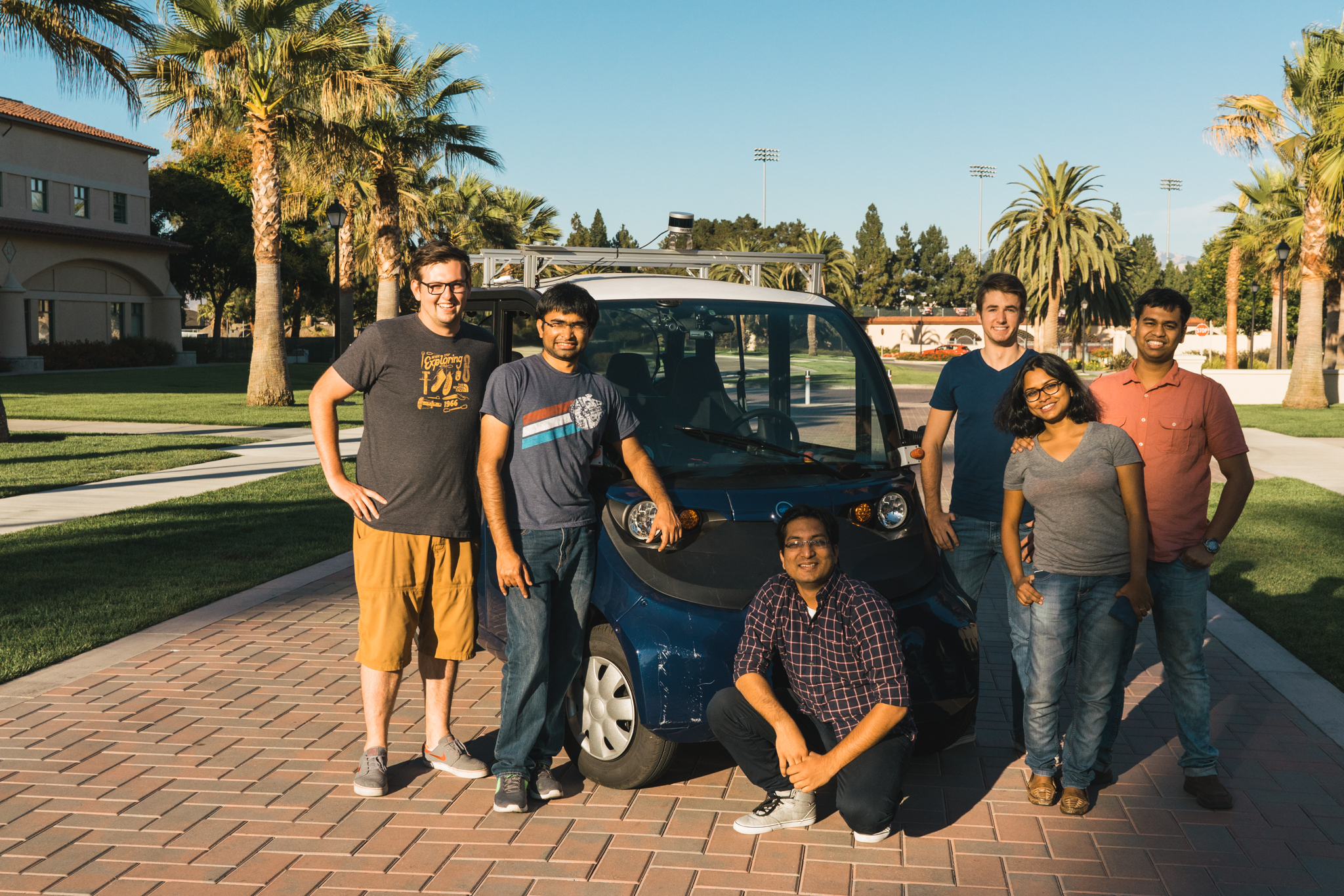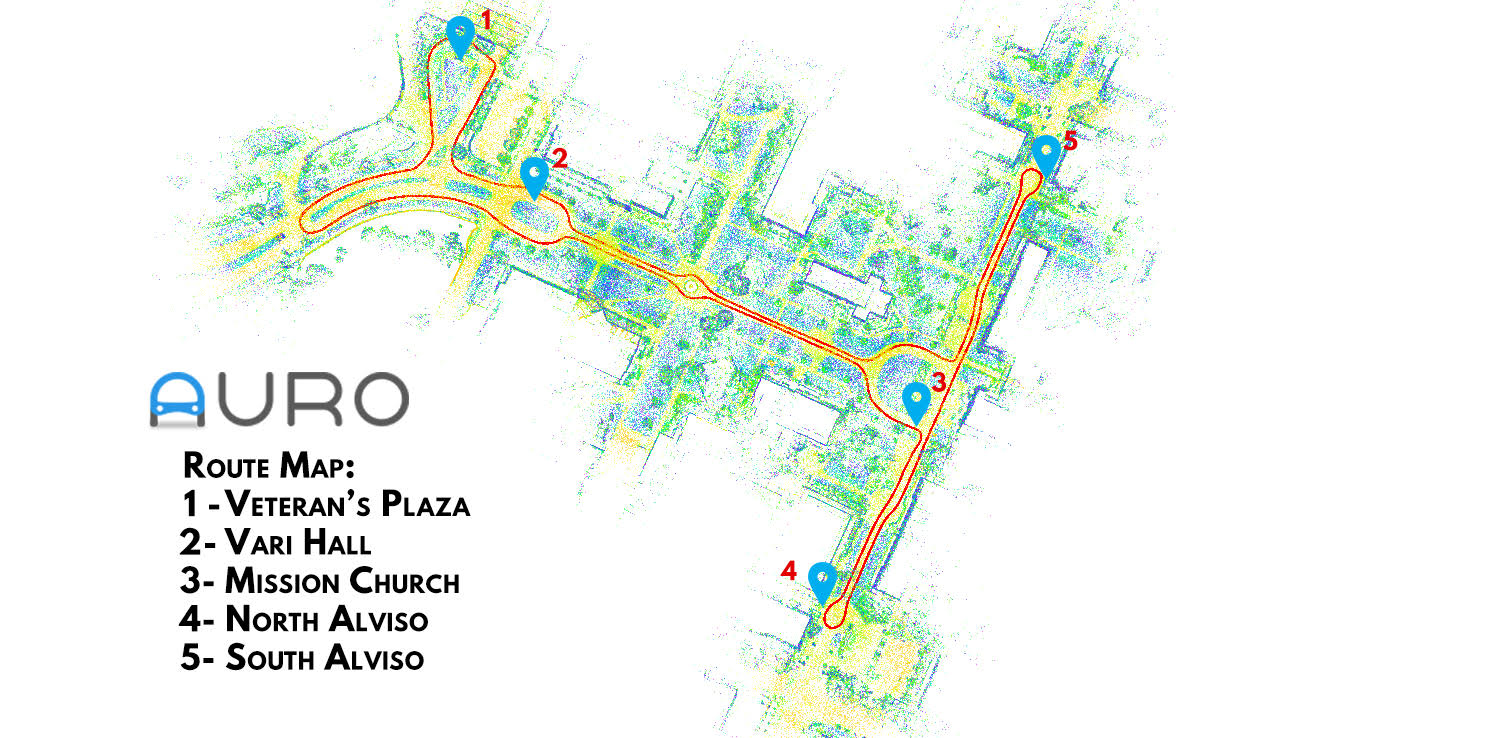Autonomous Vehicles Cruise into the Future
Driverless golf carts will start giving rides on campus this month
Sophie Mattson THE SANTA CLARA November 10, 2016

The university community will soon have the chance to hitch a ride on a vehicle that moves through campus without a driver pushing the gas pedal or turning the steering wheel.
Starting on Nov. 14, students, staff, faculty and campus guests will have the opportunity to ride around campus in an autonomous vehicle, a modified golf cart developed by Sunnyvale-based startup Auro Robotics, for a pilot period until Feb. 7.
The shuttle will travel on a set path in a loop spanning from the Mission Church to the area near Vari Hall on the Abby Sobrato Mall and temporary A-frame signs will be placed around the route to indicate drop-off and pickup points.
The autonomous shuttle service is believed to be the first such program on a college campus, according to Ben Stinnett with Auro Robotics. The company teamed up with Santa Clara back in 2015 to begin beta-testing their autonomous vehicle technology on the palm-lined campus. Although back in 2015 the university stated they wanted to allow students to ride on the shuttle, the plan has not come to fruition until now.
The shuttle will operate from 8 a.m. to 11 a.m. and from 1 p.m. to 5 p.m. Monday through Friday. The service will also run from 9 a.m. to noon on Sundays to accommodate the church crowd.
“Specifically for people who have mobility impairments, the shuttle could make it easier to reach their destination. There are a lot of possibilities for the shuttle, expanding routes on campus and expanding service windows,” said Tim O’Keefe, business technology applications manager with University Operations.

An Auro safety engineer will be onboard the entire time during the rides, and the vehicle will be able to seat three additional riders at any given time. The vehicle can be manually operated using a joystick, since the steering wheel will be removed to indicate to the public that it is indeed an autonomous vehicle. The vehicle can run at speeds as high as 25 miles per hour, but will be restricted to 7 miles per hour for the shuttle rides.
Auro was formed about a year and a half ago, after its co-founders began developing an autonomous vehicle project at their university in India.
They brought the company to the Bay Area, and then began testing their autonomous golf cart on campus.
Stinnett said that the vehicle uses laser technology that can see a “football field” in front of the car, and senses pedestrians and other hazards. If it encounters a hazard, like an absent-minded pedestrian or a longboarder, the shuttle will stop.
Lionel Robert, a professor at the University of Michigan who specializes in human autonomous vehicle interaction, said that having the vehicle drive around on a set path for many hours a day can likely increase the potential for accidents and collisions with the vehicle.
“If someone is on a skateboard and they come by me I can take a step back,” Robert said. “I can move out of the way because they are going to hit me. That car cannot do that. I can stop, but it can’t take a step back. Accidents still can happen because you have a physical entity on that path so it has the potential of blocking someone else. Even if it’s not the technology’s fault you still can have an accident.”
However, O’Keefe and Stinnett assured that the vehicle has been throughly tested and is safe to operate on campus.
"We see the shuttle operating for many hours on campus without incident,"
There have been remarkable developments in autonomous vehicle technology in the past few years, with many high-profile universities like UCLA, Michigan and the University of California, Berkeley and car-production companies like Toyota investing considerable time and funding into research. Tesla recently rolled out a software update allowing drivers to take their hands and feet off the wheel when operating the sleek, $83,000 electric car.
Despite all this progress, Alain Kornhauser, a Princeton University professor who specializes in aeronautical engineering and automotive systems engineering said that completely driverless cars on the open road or public areas are “nonexistent,” even though some people have operated driverless cars on closed dirt roads or closed parking areas.
“They are not really autonomous if there is a driver in there,” Kornhauser said. “There is a capable driver that is ready to take over if something should go ary.”
Kornhauser said that there has been a global effort to develop completely driverless cars.
“There are a number of efforts and initiatives around the world that are working towards having driverless mobility and it’s something that many of us want to achieve but yet nobody has done,” Kornhauser said. “Google has not set its driverless car out on any road driverless without closing the road down.”
Stinnett asserted that their car is still considered an autonomous vehicle, even if a safety engineer is present, saying that the engineer is “only there to intervene.”
“We don’t want people to see it as a novelty or PR stunt,” Stinnett said.
Stinnett could not provide a timeline for when the vehicle would operate without a safety engineer on board, although it is one of Auro’s eventual objectives.
“The bottom line for us is that safety drives everything we do and we won’t be willing to remove the safety driver until we are 100 percent confident that it is the right choice to make,” Stinnett said.
Kornhauser said that it would be an “enormous achievement” for Auro Robotics to operate the vehicle without a safety engineer onboard, since it would indicate a very high level of reliability after only a few months of testing.
“I would give them a big bravo,” Kornhauser said. “For the university to permit them to operate this vehicle on their property they would have to feel very comfortable that the expected liability associated with the operation would be miniscule.”
ASG President Lidia Diaz-Fong and Senate Chair Neil Datar said they support the program because it helps increase accessibility for disabled individuals. The two have proposed several initiatives to the university regarding the future of the program, such as eventually expanding the route to a larger area of campus,painting the vehicle Santa Clara colors and naming it the “Bronco Mobile.”
“We really see this as something that could be expanded to residence halls where students live and help them get all the way across campus not just from the parking structure to the classroom,” Diaz-Fong said.
This is not the most recent initiative to increase on-campus transportation. Last year, Datar and 2016 alumnus Jason Back launched the startup “Buckshaw,” a safe ride rickshaw-based transportation service that would transport students within a half-mile radius of campus between 9 p.m. and 3 a.m. Tuesday through Saturday.
Although the initiative hasn’t formally launched yet due to roadblocks and red tape from the city of Santa Clara, namely over concerns that the company would compete with existing pedicab businesses in the area, Datar hopes the automated vehicle will eventually help accomplish some of Buckshaw’s goals.
“We are hoping that the Bronco Mobile may be able to fulfill some of the strategic goals from the Buckshaw program and we are hoping for a late night route in areas where students traffic late at night,” Datar said.
Contact Sophie Mattson at smattson@scu.edu or call (408) 554-4849
